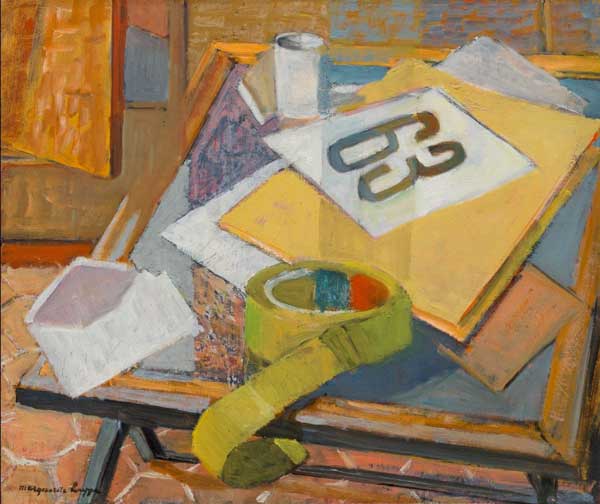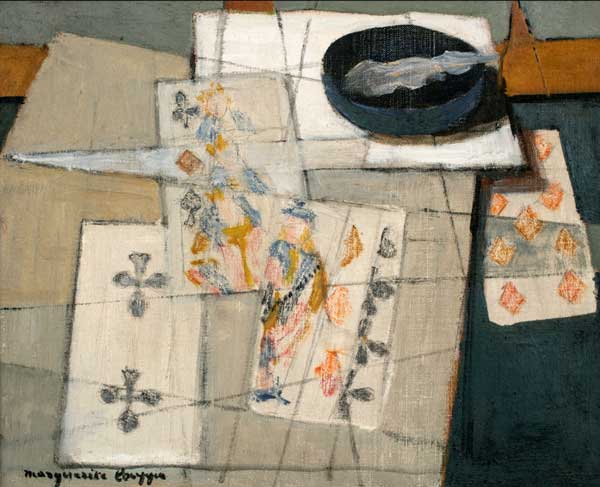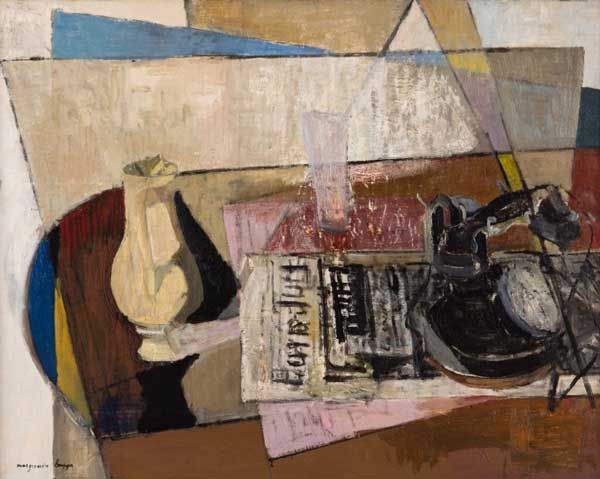| At the Académie Julian, Louppe met the painter Maurice Brianchon, whom she married in 1934. Throughout their marriage, Louppe often acted as a manager to Brianchon's career, while still cultivating her own artistic practice. Louppe exhibited her work at the Galerie Charles-August Girar, Galerie Druet, Galerie Louis Carre, and Galerie Rene Drouet. A major shift occurred in her work in 1960, when the couple purchased a country home in Truffières; for the first time in her career, Louppe had a dedicated studio space. |
 |
| Marguerrite Louppe, Numéro 63. Oil on canvas, |
| Her studio became one of Louppe's primary subjects, and her early, soft interior scenes evolved into theoretical examinations of artistic practice itself. Consistent rendering of her work surfaces and tools led to Louppe's mature style, which draws upon Cubism and Purism while maintaining her indelible familiarity. She investigated the correlation between the lanky forms of easels with the wide perspective of the surrounding space, and repeatedly painted tables strewn with quotidian or craft-oriented objects; brushes, fans, and flowers were juxtaposed with sketchbooks and draftsmen's triangles. |
 |
| Marguerite Louppe, Jeux de carte. Oil on canvas. |
| The garden and landscape surrounding Truffières became Louppe's other main subject, and by the 1960s, her landscapes utilized both a Diebenkorn-like abstraction and the linear refractions seen in her earlier work. The American critic Saul Ostrow described this stylistic shift: "Diagonal force-lines that had once dominated her compositions are replaced by true verticals and horizontals, which define rectilinear forms of modulated color, pushing her Cubism toward Synchronism." In the final period of her artistic life, Louppe exhibited at Galerie des Granges in Geneva in 1978, at the Galerie Yoshii in Paris in 1980, and her final exhibition was at the Galerie Paul Valotton in Lausanne in 1985. The last ten years of Louppe's life were plagued with declining vision and eventual blindness, but she maintained her practice; Louppe believed that painting is a calling, similar to joining a monastic order, and that it demands all the time and devotion one can give. |
| Marguerite Louppe will be on view March 1–March 22. To see a full list of works in the exhibition, click here. |
|
Rosenberg & Co.
19 East 66th Street
New York, NY 10065
212 202 3270
Cette adresse e-mail est protégée contre les robots spammeurs. Vous devez activer le JavaScript pour la visualiser.
http://www.rosenbergco.com/
|





